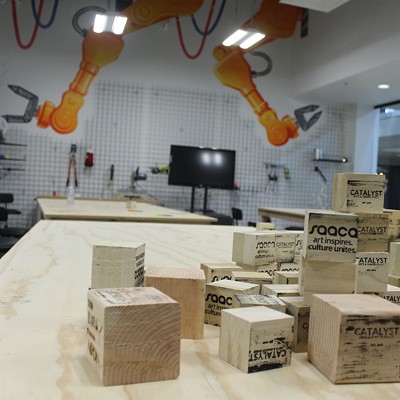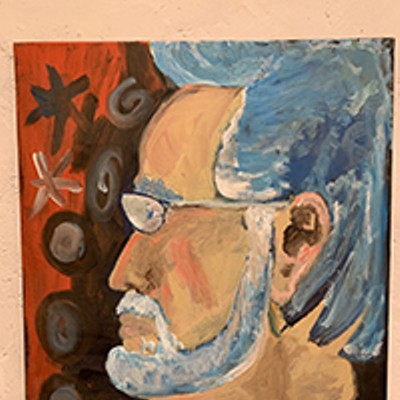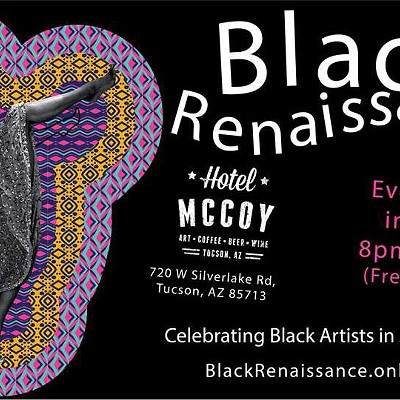Not only was she handling works by traditional artists "I grew up wishing I could meet"--Geronima Montoya, Pablita Velarde, Ruthe Blalock Jones, Fred Beaver and Tony Da--she was delighted to realize that the names were familiar for another, more personal reason. During the 1990s, when she was a professor at the Institute of American Indian Art in Santa Fe, Yazzie, a printmaker, had taught some of their descendants.
The state museum's new Avery Collection, "holds many important works produced by many great American Indian artists from the past 30 years," she wrote in a catalog essay for the show, Connections Across Generations: The Avery Collection of American Indian Paintings. "... I even was lucky enough to teach some of these artists' children, who are now excellent artists in their own time."
Yazzie is a link between the generations in more ways than one. A Navajo who grew up on the rez in Ganado, Ariz., Yazzie combines her contemporary prints with collages; her prickly art comments on the uneasy position of Native Americans in larger American life. She's university-trained, with an MFA from the University of Colorado, and she's taught at the UA and this year is a visiting prof at Boise State University in Idaho. Despite this academic background, she's come to realize how important both her grandparents were in shaping her contemporary aesthetic.
Her grandma, she says, was a traditional rug weaver and her grandpa was a railroad worker who tinkered, making doors out of signs and gluing together found objects into interest concoctions around the house.
"They really helped make me what I am as an artist," she says.
A generation ago, in the 1960s, young Native American painters such as Fritz Scholder rejected what they considered the straight jacket of tradition, with its repeated stylized representations of the natural world and communal ceremonies. Scholder shocked traditionalists by painting contemporary Indians--wrapped in flags, holding beer cans--in a painterly Expressionist style. Now another mini-revolution is under way. Yazzie and other cutting edge Indian artists today--call them the new radicals--honor the tradition but they're taking it in provocative new directions.
"I see myself like these (traditional) artists in the way that I am speaking about my experience in my work," she says. "It may be abstract and use techniques such as printmaking but it is all saying the same thing -- we are proud of who we are and our history should not be forgotten.
BY COINCIDENCE, TWO large painting shows on view right now in Tucson allow the traditional and contemporary Indian artists to speak to one another across the generational divide. (A third show, a Scholder retrospective, opens at the University of Arizona Museum of Art Feb. 14.) At the Tucson Museum of Art, contemporary curator Julie Sasse has mounted Common Ground: Contemporary Native American Art from the Permanent Collection and Private Collections. The Common Ground painters, many of them university-trained, work in contemporary styles far removed from the flat painted pictures of their forebears.
They wield brushes load with oil paint, creating luscious illusions of depth on their canvases, and they don't hesitate to collage newspaper headlines and other found objects onto their paintings. Jaune Quick-to-See Smith, for instance, a highly regarded painter of the Flathead Salish tribe, has made a scathing critique of a broken compact between the U.S. government and her ancestors in her 2000 "Sovereign Nations." She's glued fragments of a copy of the 1859 Treaty of Hellgate to her canvas, where she's painted an abstracted vision of an Indian woman's dress, ghostly in yellow and ochre.
Likewise, Emmi Whitehorse, a Navajo who was selected for the TMA's Stonewall Exhibition four years ago, paints large, contemporary works that inspired by the old ways, including the herbs her grandma used to hang on the walls of her house. Her "Keyah (Blue)," an oil and chalk on canvas from 1993, is a blue-gray ground haunted by white doodles of figures and crosses and curves. It conjures up a cave, filled with ancient rock art.
"In many cases there's a relevance to the symbols of traditional cultures but it's not a given," Sasse says of the 18 pieces in the show. The traditional elements "can be a component or a launching pad, but these artists are as advanced as any other painters and steeped in the influence of the real (outside) world."
Over at the Arizona State Museum, the precedent-setting exhibition Connections Across Generations has no fewer than 90 paintings. Some works hint at outside influences, such as Carl Gorman's Cubist-inspired 1966 painting of Navajo women, and some offer social critiques, like Valjean Hessing's depiction of one of the many forced marches inflicted on Native Americans. But most fall within the tradition. Characterized by simple outlines and flattened figures, and garnished by ancient symbols, the paintings are highly decorative renditions of age-old Indian life. Graphic patterns familiar from basketry and pottery recur again and again. David Dawangyumptewa, of combined Hopi/Navajo descent, has made a luminous update of old designs, all flying creatures and swirls, in his 1989 watercolor "Flight of the Dragonflies."
Paintings of the animals and the natural world are common, as is a tongue-in-cheek humor, such as Beatien Yazz's painted porcupine aiming an arrow at a dog. Ceremonial pictures abound. The charming "St. Francis Feast Celebration," a 1986 watercolor by Tohono O'odham artist Mike Chiago, cheerfully depicts a community ritual.
Chiago, who will give a talk at the museum Nov. 15, is typical of the Avery artists. Now 57, he studied commercial art at Maricopa Community College after coming back from war service as a Marine in Vietnam. But he taught himself to paint, he says, drawing his subjects of traditional O'odham life from his mother's stories.
"I do my people, how they live now and they lived a long time ago," he says by telephone from his home in the northern part of the reservation. "It's everyday life."
Co-curated by associate director Hartman Lomawaima, the Avery show draws on 360 paintings donated to the museum in 1999 by Marjorie Pierce Avery, an elderly Texas collector who grew up in Arizona and attended the UA. Dating from 1935 to 1990, the bulk of the paintings come from Arizona and New Mexico, with a few hailing from Oklahoma. Famed for its treasure trove of prehistoric Indian pottery, the ASM is primarily an anthropological museum.Until Mrs. Avery's donation came the museum's way, it had virtually ignored the phenomenon of 20th-century Indian easel painting.
"This is absolutely a new direction for us," Lomawaima says delightedly. A Hopi who grew up Second Mesa, Ariz., he too found personal connections in the collection. His grandparents were artists--his grandfather made jewelry and his grandmother baskets--and when he first pored through the collection, he found works by artists who had been some of his grandparents' dearest friends.
The two shows do overlap a bit, with the placement of some of the works confounding expectations. R.C. Gorman, a Navajo artist, has won fame and fortune with his commercial images of Navajo women. But it's the TMA that has one of these tiresome works, an untitled lithograph from 1972, and the state museum that has the more surprising Gorman: a lovely near-abstraction based on pottery designs.
David Bradley, a 48-year-old Ojibwa/Sioux who lives in California, is also in both. He's inclined toward humorous send-ups of art history, recasting famous works Indian-style. His "Rio Grande Madonna" at the State Museum remakes the Mona Lisa as a Pueblo woman, complete with ambiguous smile and a New Mexican landscape. Over at TMA, his "Hopi Maiden, Homage to Warhol" is a neon-colored pop art takeoff, with the Hopi maiden's image repeated, Warhol-like, four times. He's having a little fun, but it's pointed. His question is well taken. Where do Indians--and Indian art--fit in in the grand sweep of history?
AVERY GREW UP BLISSFULLY unaware of it. Her parents ran cattle near Phoenix, on land now laid waste by the city's suburban sprawl; as collectors they favored Navajo weavings and Hopi pottery. Not until she was an adult did she see contemporary Indian easel painting. One was enough to fuel an addiction. "Over 40 years ago, the purchase of a single painting grew into what is now the Avery Collection," she said when she made her gift.
She's not the only one to come late to Indian painting. It's a commonplace to note that Native Americans did not start painting on paper until after "contact" with whites, but they've been painting on other surfaces for millennia.
"It's a long legacy, a long history," Lomawaima says. "They used mineral sources as paint."
To make the point, he and Yazzie positioned a couple of prehistoric stone works painted with Hopi symbols at the entry to the Connections show. Each of the stones is about 600 years old. One, a long vertical slab, is painted with a Hopi sun in orange and blue gray.
Archaeologists have recently discovered that the Southwest's first potters lived in the shadow of Tucson's A Mountain 4,000 years ago. If they were not yet painters, the decorative impulse was already there--they incised their clay cups with thumbnail marks. But full-fledged painters soon began to flourish. The ancestors of the Hopi worked in a surprising rainbow palette, from reds to yellow to black and brown. The Hohokam, who lived in Southern Arizona 1000 years ago, favored a more limited palette: red on buff in simple geometries.
The Hopi painted murals on the walls of their kivas, and paintings on the cliffs of Canyon De Chelly show what appear to be Spaniards on horseback. The Navajo made highly stylized sand paintings. The arrival of the first whites, along with its catastrophic consequences for Native American life, liberty and culture, also had complicated implications for art. White traders--and a white market for Native American goods--helped change weaving traditions, for instance, with the traders actually instructing weavers which designs to make. Americans introduced paper and crayon to Indians. But what the artists were to depict was problematic.
Mission boarding schools initially wanted their Indian pupils to make art as "white" as the trousers and pinafores they were forced to wear, according to Clara Lee Tanner, writing in her landmark book Southwest Indian Painting. But that was before anyone realized the coming tourist trade in Indian art. Tanner quotes an unnamed Congressman, "Who wants to go West to buy a picture painted by an Indian of three apples on a plate?"
By the early 20th century, it was clear that Indian art would sell. Dorothy Dunn started a painting program at the Santa Fe Indian School that encouraged students to explore their native traditions. Dunn apparently was a benevolent teacher, who deeply admired Indian art, and tourists were happy to buy. By 1950 Joe Herrera rejuvenated the style with his "Pueblo Modernism," an innovation that capitalized on the abstract and symbolic qualities of traditional design. But by the 1960s, critics began to believe that the new Santa Fe style run its course, promoting a stultifying, a rigid concept of Indian art that had no relationship with contemporary life. Scholder, fresh from a master's program at the University of Arizona, arrived to teach at the new Institute of American Indian Arts and found a town mad for Indian art, and frozen in a world of flat painted "Bambis" created for the tourist trade.
Scholder and other artists, including T.C. Cannon, shocked tribal elders, artists and dealers with their blunt depictions of real Indian life. Drawing on his university training, and his knowledge of expressionist European artists like Francis Bacon, Scholder delivered a new kind of Indian art. Thickly painted on big canvases, his Indians were carrying beer cans, wrapping themselves in American flags, and otherwise acting like complicated modern people. Scholder's work was exhilarating and life-altering for innumerable younger artists. But a generation later, artists who are rediscovering the tradition might say that Scholder had thrown out the baby with the bathwater.
Traditional art, for all its prettiness, is deceptively unassuming. Sure it's been influenced by the marketplace--why not make a living painting if you can?--but it also has a deeper value. Melanie Yazzie argues that the work of artists like those in the Avery Collection asserts the importance of their own lives and culture.
"The pieces are very much about everyday life in Native American society," she says. "These artists painted and made art about what was happening around them."
Traditional artists like Gerónima Cruz Montoya of the San Juan Pueblo were casualties of the Indian art revolution that hit in the '60s. She lost her teaching job when the Institute of American Indian Arts replaced the older Santa Fe Indian School founded by Dunn. Debates about that transition are highly politicized, with some arguing that the Institute, by favoring advanced European and American abstract styles, was actually a force for assimilation. Tribal values, and communal traditions, so the argument goes, were abandoned in favor of a new American individualism.
In any case, works like Montoya's flat, stylized "Deer in the Fall," in the Avery Collection, were no longer prized. Yazzie hopes that with this show, those kinds of judgments will change.
"As a younger artist I feel that I would not be able to make the work I am making now if it were not for these artists," Yazzie says. "They really paved the way for the younger generation. At times in the past I did not feel the same but as I have grown older I see that they are very important role models and should not be forgotten."














